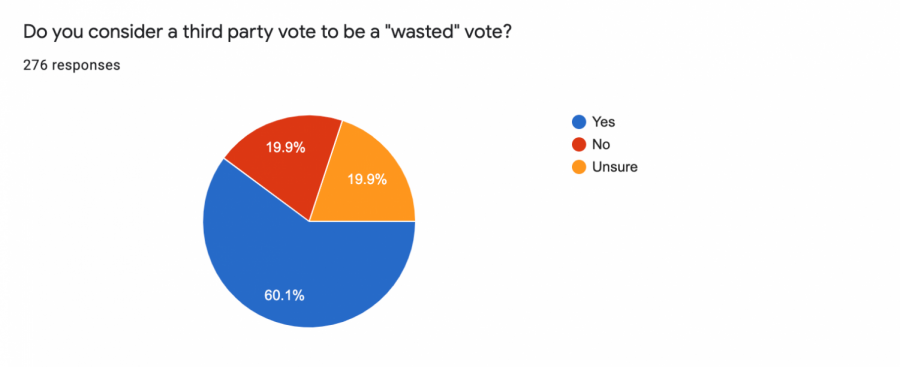America’s two party system: Yesterday, Today, and Tomorrow.
Chaos. The perfect word to describe the U.S.’s current political situation/environment, and what we have normalized into our day-to-day interactions. Today, it is almost impossible to go an entire day without being exposed to politics; whether you are scrolling through your Instagram feed or even at the dinner table, there is no escaping it. This can be exhausting to most and has led many people to question how we ever allowed this country to become so divided. There are many answers to this question, however, we first have to understand the history of the American two-party political system.
Our first president, George Washington, famously stated his dislike for party systems in his Farewell Address:
“However [political parties] may now and then answer popular ends, they are likely in the course of time and things, to become potent engines, by which cunning, ambitious, and unprincipled men will be enabled to subvert the power of the people and to usurp for themselves the reins of government, destroying afterwards the very engines which have lifted them to unjust dominion.”
- George Washington Farewell Address Saturday, September 17, 1796
It can be inferred that this message was directed at the new opposing parties that had emerged in the years prior to this speech, but evidently, it had little impact on their future decision making. These two new parties were known as the “Federalists”, or constitutionalists who supported enforcing the constitution, and the “Democratic-Republican” party, which rivaled the Federalists and contained the beliefs of what we call today, Jeffersonian Democracy. The Federalists were largely founded by Alexander Hamilton, and the Democratic-Republicans by James Madison and Thomas Jefferson. In hindsight, we can see that this is an early example of divide within the American political system. Right here, in this very specific part of history, we see one party supporting a stronger and more involved central government, versus another party with a libertarian approach. Obviously, these are completely polar opposites within the political spectrum and any form of radicalization in either party cannot exist within what we call American democracy.
Eventually, over the course of many decades of American advancements/evolution, came a political change. With new ideas came new inventions, and with new inventions came new innovations, with new innovations came new beliefs about these innovations, and with new beliefs arose new cliques of people with the same ideas that became new political parties. To digress, with new parties coming to rise, only ever did two really stand out, which is very important to notice. The Federalists and the Republicans evolved into different parties and interchanged, and most modern-day democrats believe that at one point the parties switched (whether or whether not this occurred is a long topic for another discussion). As stated previously, the development of political parties and the shifting policy priorities of the country were in a strongly correlated relationship: policy always chasing the shifts in political opinion. This eventually all took a big shift that went unnoticed at the time.
Towards the end of the 19th century, shortly after the Emancipation Proclamation was declared, we can see one large shift. Politics was changing quickly, but now there was a fundamental change in the system; instead of the political class reacting to social opinions, society was now dependent on new legislation and the political class. Both the social and political were changing at exponential rates trying to unknowingly outweigh the other.
Fast forward to the 21st century and we see the internet and invention of the cell phone start to gain popularity. Both of these tools helped double the rate of not just American, but human change as a whole. The constant output of information led to what can be called an “informational overload”: news outlets putting out not just political articles but normal day-to-day periodicals at a rate never seen before. This had an immense impact overall, but specifically with Gen-Z, we can make the connection that through the internet they were exposed to the American political environment at a relatively young age, which is very unique compared to the previous generations. This along with many young activists sparked a wildfire within the younger audiences’ interaction with politics. This can be viewed as a positive and negative depending on how you look at it; from a positive standpoint, it is preparing young adults for the real world and making many positive changes. From a negative point of view, this allowed for the spread of many exaggerated stories and misinformation through news and social media outlets. Many times, depending on how biased a media company is to one side of politics, the more likely they are to present that side of news as being greater and exaggerating its accomplishments and feats. (It can also be added that this forced teens to lose their sense of childhood at a young age and unwillingly have to be engaged in politics.) So now, not only are the older people in Congress and governmental positions split between themselves, but also young teens on social media. People these days are usually split between two different parties, whose names are technically umbrella terms for more diverse political labels and identifications.
The Democrats and the Republicans. As stated earlier, both of these parties are composed of different subgroups and radical individuals. The problem we have come to is that there is just too much to decide on one party. There are so many topics for discussion that could not have been imagined 200 years ago: abortion, equal treatment for the LGBTQ+ community, gender and POC equality, whether we should have the 2nd Amendment, and so many more. There is just too much at stake to vote for specifically one of two parties because realistically, neither party truly represents all of the values of any one individual, no matter what label you fall under. Not to mention, that people are pressured very heavily by both sides to vote for which side favors their view on a particular issue. Rarely does a bi-partisan vote occur, and when it does it is usually glorified by both sides, which is ironic because compromise is exactly what politicians are expected to do in order to govern efficiently. To follow up, a question people may ask is why we should even have to choose between two parties who apparently are being super radicalized away from their initial ideologies. That is a great question.
In a technical sense, we in America do not have a two-party system, however, how often do you hear about Green Party plans for environmental awareness or Libertarian candidates in Congress? Almost never. The last time someone other than a Republican or Democrat won a state in a presidential election was in 1968: George Wallace who ran as an Independent. The reason why it comes across that we are a two-party system is mainly due to media coverage and the sake of tradition. Most of the time, third-party candidates are not given nearly as much attention as republican or democratic candidates, and most fail to meet the requirements necessary to join the presidential debates. Today, the majority of Americans believe that voting for a third-party candidate takes votes away from the two main party candidates. In a recent poll we conducted here at Shaker High School, it turned out that around 60% of the Shaker population considered a third-party vote to be a “wasted” vote, and almost 20% were unsure. These statistics obviously speak for themselves, and further support the point that we are really only a two-party system. It is nearly impossible for a third-party candidate to gain support without media coverage, and the two-party system has monopolized our way of conducting a “fair” election. For the sake of our political integrity, we can no longer functionally vote based on a 2-party system, at least not before we become so divided that we can’t hold a steady election again. The 2020 presidential election between Joe Biden and Donald Trump proves this point perfectly: The day when Joe Biden was declared the presidential candidate for the Democratic Party, it was like a back and forth game of tennis between every Democrat and Republican as to why the opposing candidate is terrible, leaving a third option completely out of the argument. The tensions were very high and at the first presidential debate between the two, it was like fire and ice on the stage. They had quite literally nothing in common, except for the fact that they were both running for president. Post-debate, people on both sides agreed it was a mess. Is this the example that should be set in the minds of young people who want to run for president or any governmental position in the future?
(He/Him) is a Junior at Shaker and is a part of the Podcast team in the Shaker Bison. He has been a member of the Bison for three years and is also active...


